Video transcript Ancient_Lunar/Solar_Bible_Calendars and
Supernatural at youtube.com timeemits channel includes Ages of Adam
Presentation with text, slides and clips. Genesis definitions for
Lunar and Solar Time Splits, book materials, and ISBN introduce the
ministry.
Ancient_Lunar/Solar_Bible_Calendars_and_Supernatural
13:47
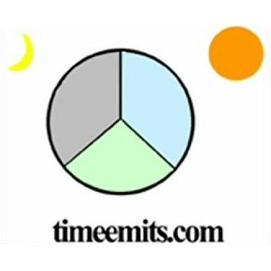 Ages_of_Adam
Presentation source telogovidcr62pcqb.png 0:5 leader
followed by desk speech
Ages_of_Adam
Presentation source telogovidcr62pcqb.png 0:5 leader
followed by desk speech
Welcome to the Ages_of_Adam
presentation. This presentation gives you an overview for the Time Emits Ages_of_Adam website.
We will be working with ancient lunar/solar calendars and those
calendars that help us understand the calendars of the Holy Bible. My name is Clark
Nelson. I am the author of Ages_of_Adam
and webmaster for timeemits.com.
Slide1AoA.mp4 1:06 2.85 mb original followed by
Slide1apic50pcb.png for 0:10
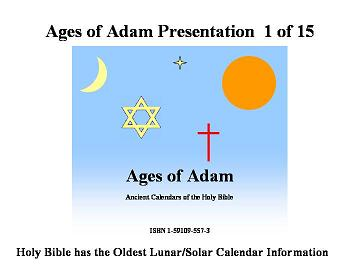
Slide 1 of the presentation shows the Ages_of_Adam cover design. The moon at the top is
for the lunar-side and the sun symbolizes the solar-side of the
lunar/solar calendar. The blue star represents the Jewish
lunar/solar calendar and the red cross embodies Christianity. Ages_of_Adam is subtitled: Ancient Calendars of the Holy Bible.
History and spirituality are combined in this amazing Bible study. Calendar research
penetrates to the core of time.
Ages_of_Adam Presentation, Cover with ISBN 1-59109-557-3
Ancient_LS_Bible_Calendars
and_Supernatural
|
|
Related Articles
provides an overview that connects the Mayan calendar with
the earliest Bible calendar -- the Antediluvian
Patriarchs.
derives the Begat Genealogy of Adam in
Genesis 5.
Iincludes general calendar flow starting from seven
day weeks and lunar phases.
|
Ancient Calendars Measure Time:
Jewish, Egyptian, Mayan Dates
Slide2AoA.mp4 2:04 original 6.1 mb with Slide2pc50b.png 0:15
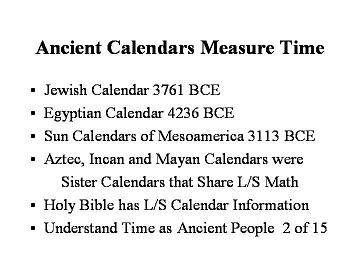 Ancient
calendars measure time according to the sun, moon and stars. There
are three forms of ancient calendars to consider. All three types of
calendars measure differences between lunar months and solar-sun
time in the same way. The oldest lunar/solar calendar systems known
are the Jewish Calendar, Egyptian Calendar and Mesoamerican
Calendars (formerly Sun Kingdoms Calendars of Mesoamerica).
Ancient
calendars measure time according to the sun, moon and stars. There
are three forms of ancient calendars to consider. All three types of
calendars measure differences between lunar months and solar-sun
time in the same way. The oldest lunar/solar calendar systems known
are the Jewish Calendar, Egyptian Calendar and Mesoamerican
Calendars (formerly Sun Kingdoms Calendars of Mesoamerica).
The Aztec, Incan and Mayan calendars were Mesoamerican sister
calendars that all share similar lunar/solar calendar mathematics.
Each calendar system spans hundreds to thousands of years. For
example, the Jewish Calendar dates from 3761 BCE, or Before Common
(Christian) Era. The Egyptian Calendar estimate begins 4236 BCE.
Mesoamerican Calendars began about 3113 BCE. Over the course of many
lunar/solar cycles, time accumulates.
Foundational lunar/solar calendar patterns are present in the early
chapters of Genesis. If you
had something that was; say a hundred years old, it would likely be
worth a great deal. Something 500 years old is worth even more and
may belong in a museum somewhere. An artifact that is 1000, 2000, or
even 5000 years old becomes a national treasure. At 10,000 years old
or more, we are sure the item is priceless to the world. Any Holy Bible has this information.
You may have the written knowledge in your home right now.
Lunar/solar calendars allow us to understand time as the ancient
people once did.
Four Phases of the Moon
Moon as the Earliest Calendar Slide3AoA.mp4 2:25 6 mb
original, voice over with Slide3pc50b.png 0:15
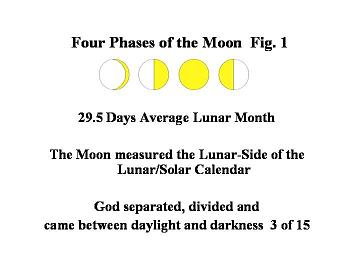 I
will begin with some elementary patterns concerning the moon. Figure
1 shows the Four Phases of the Moon. Our modern calendar is
of course, based upon twelve months. A lunar-moon-month always
includes 4 phases: new moon, first quarter, full moon and the
last, fourth quarter. The sacred seven-day-week was used in
ancient Bible times to
measure the 4 phases of the moon. The typical ancient lunar month
was 29 or 30 days. In the time of Noah, months were
counted using 30-days. Average lunar months of 29.5-days
are close to the more precise 29.53-days. We are not directly
talking about the Creative Week, although most Jewish
historians agree the moon and lunar phases were fundamental to early
scripture. The moon was the earliest calendar instrument.
I
will begin with some elementary patterns concerning the moon. Figure
1 shows the Four Phases of the Moon. Our modern calendar is
of course, based upon twelve months. A lunar-moon-month always
includes 4 phases: new moon, first quarter, full moon and the
last, fourth quarter. The sacred seven-day-week was used in
ancient Bible times to
measure the 4 phases of the moon. The typical ancient lunar month
was 29 or 30 days. In the time of Noah, months were
counted using 30-days. Average lunar months of 29.5-days
are close to the more precise 29.53-days. We are not directly
talking about the Creative Week, although most Jewish
historians agree the moon and lunar phases were fundamental to early
scripture. The moon was the earliest calendar instrument.
Changes in the appearances of the moon provided the seven-day
week. Originating with ancient interpretations of lunar time,
divisions of seven-days separate the four basic lunar phases. By
actual observation, ancient calendar makers recorded approximations.
A lunar month was determined by sighting the new moon crescent.
Lunar/solar calendar foundations of the Jewish calendar extend from
the earliest verses of scripture. Natural, uniform motions of the
heavenly spheres are the pivotal markers of lunar/solar time
reckoning.
365 Day-Solar-Year and Eqn. 1 Ages_of_Adam
p. 18
Slide4pc50b.png 0:15 followed by Slide4AoA.mp4
original 3:20 8.0 mb

Intercalary days are added to the lunar year of twelve-moon-months
in order to complete our modern solar year of 365-days. The
necessary intercalary days are best described as lunar/solar
separation time by "God coming between" lunar and solar times.
Twelve lunar months multiply by an average 29.5-day month for
354-days to approximate the lunar year in equation 1. The moon
measures the lunar-side of the lunar/solar calendar.
Eqn. 1. 29.5 Days per
Lunar Month
x 12 Lunar Months LS Calendar Year
= 354
Days per Lunar Year
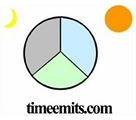
|
Get Ancient_LS_Bible_Calendars_and_Supernatural_Video_&_Script
includes Ages_of_Adam slides and clips. Genesis
definitions for Lunar/Solar Time Splits, book materials, and
ISBN introduce the ministry. First video trial using a
presentation format.
Cart Item ALSBCSVT includes Video 6
download .mp4, 32 mb 13:47 and transcript PDF 481
kb from
Paypal-Payloadz
eStore for Only $ 1.98
|

V-32 mb
T-481 kb
1.98 |
11 Days Lunar/Solar Time Split and Eqn. 2 Ages_of_Adam
p. 18, Slide5pc50b.png 0:15
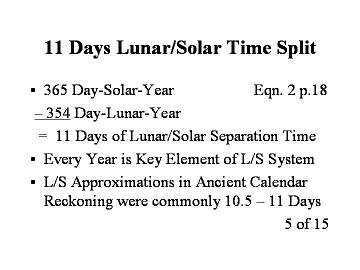
Eqn. 2. 365 Day-Solar-Year
-354 Day-Lunar-Year
= 11 Days of Lunar/Solar Separation Time Split every year is
key to L/S systems
10.5 – 11 Days L/S Approximations in ancient calendar reckoning
were common
• Lunar-side =
354 Day-Lunar-Year
• Midpoint of Lunar/Solar Calendar Year = 360
Days
• Solar-side = 365 Day-Solar-Year
Author's Note: Situated
midway between 354-day lunar years and 365-day solar years was the
very ancient form of 360-day calendar year. Some 12-lunar-months
of 30-days each count to achieve years. Naked eye observation
naturally results in diverging lunar and solar calendar patterns.
Lunar/solar calendars served to bridge the time gap with
intercalary days. A 360-day midpoint year is an
effective tool for deriving alternative lunar/solar calendar
systems. The key to lunar/solar systems is 10-days or 11-days of
separation time.
The transition from lunar-side to solar-side reckoning introduces
the most vital component of lunar/solar calendars. Twelve
moon-months of 29.5-days each count 354-days for a
lunar year. The difference between a 365-day-solar-year and
the 354-day-lunar-year is 11-days of lunar/solar
separation time in equation 2. In order for the lunar-side to
keep with the solar-side of the calendar, 11-days of lunar/solar
separation time must be accounted for every year.
Human spirituality combines religious history with lunar/solar
calendar observation. This is the ancient link to men and women.
Female fertility cycles have always been associated with the moon.
The moon and monthly periods are represented by Eve who was,
“mother to all the living.” On the other side of the
lunar/solar time channel, men were associated with daylight and the
sun. Primitive theology assigned roles having male traits or
masculinity with the standing stones of the Old Testament. The Ba-als were
pagan deities that were identified by sacred pillars, which
also marked the rising and setting positions of the sun on the
horizon. For a society dependent on agriculture, the pregnant female
Asteroth watched over neighboring farms and groves.
We are applying literal Hebrew meanings to some scriptures. For
example, when God first
divided day and night, He separated or came between, daylight
and darkness. Lunar/solar calendar systems were built by
expanding the idea of lunar/solar separation time. The lunar-side of
the calendar refers to those times measured according to the moon.
The solar-side refers to those times measured according the sun. A 365-day-solar-calendar-year
is the most common calendar instrument throughout all of history and
the companion to lunar timekeeping. The modern calendar rounds
solar-side reckoning to either 365-days or 366-days during leap
years. Ancient people were often aware of the minor leap day
fraction and generally lunar/solar calendars were based upon sighting
new crescent moons.
Lunar/solar calendar tools are developed to aid our
reasoning. The Time Split is actually a very old concept
that simply divides 11-days of lunar/solar separation time by
two. To maintain calendar complete days, whole numbers were
used for computations. The Time Split tool occurs at the 360-day
midpoint for any lunar/solar calendar year.
Additional Images:
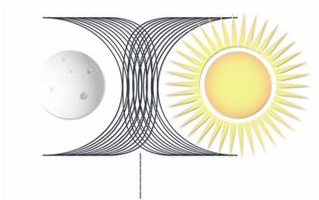 LS_linecrb.png
LS_linecrb.png
4_phases_crb.png

Slide_5a.mp4 4:07 15.7 mb showing AoAI.png with
enhancement
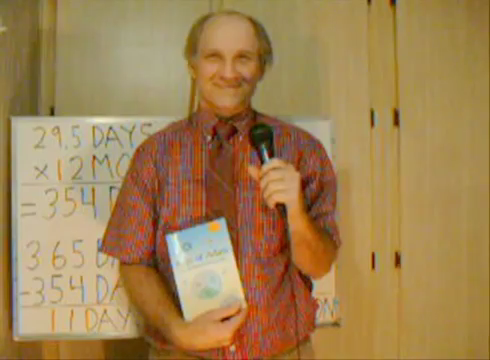 The
first Ages_of_Adam video
introduces you to the timeemits.com website. Presentation
slides, videos and full text for Ages_of_Adam
are available. You may order Ages_of_Adam
in hard print edition from Amazon or CreateSpace.com.
Search for the title: Ages_of_Adam, my name Clark
Nelson, timeemits or ISBN 1-59109-557-3. You may also
purchase the pdf download through Paypal-Payloadz eStore
for only $9.95. Each section of Ages_of_Adam has a specific link. Other resources
include articles and links to related sites.
The
first Ages_of_Adam video
introduces you to the timeemits.com website. Presentation
slides, videos and full text for Ages_of_Adam
are available. You may order Ages_of_Adam
in hard print edition from Amazon or CreateSpace.com.
Search for the title: Ages_of_Adam, my name Clark
Nelson, timeemits or ISBN 1-59109-557-3. You may also
purchase the pdf download through Paypal-Payloadz eStore
for only $9.95. Each section of Ages_of_Adam has a specific link. Other resources
include articles and links to related sites.
We identified certain facets of ancient calendars, the Bible and associated pre-historical
concepts leading to recorded time. Lunar months often counted
29.5-days or 30-days. Ancient people chose to think mainly in
whole number terms and rounded lunar and solar measurements
accordingly. Some cultures followed lunar phases as 7-day weeks.
Equation 1 results in a 354-day-lunar-year. Others
maintained solar-side reckoning, which regularly accompanies star
and planetary aspects. Equation 2 subtracts 354-days from 365-days
to amount 11-days lunar/solar separation time every single
year. Nearly all ancient people relied upon some variation of
lunar/solar calendar in order to maintain agricultural seasons.
Three subjects are of special concern: God, time and calendars. Please understand that I
don’t want to offend anybody. We are dealing with quite possibly the
oldest written evidence of lunar/solar calendar operation in Genesis, chapter 5. This portion
of the Holy Bible is
particularly sacred to me. Lunar/solar objectives suggest more at
stake than figures. Calendar knowledge gave ancient people direct
access to supernatural events. Some thirty years ago, I encountered
an incident that irrevocably changed my life, not just physically,
but eternally too. By testimony, I tell you I witnessed the writing
on a page of a book disappear before my very eyes. The book
was about the Jewish calendar. Imagine my fear of God!
Time is natural, a uniform feature in our universe that simply
happens. Time is an intangible thing that neither starts nor stops,
nor changes. Calendars are man made. Calendars and clocks are
human inventions that serve to quantify time. Ancient religions
purposely held feasts and festivals to insure sacred calendar
information continued for generations to come. In the next video,
you will learn more about ancient lunar/solar calendars. Early
people knew how to split time and open doorways to the awesome power
of God.
tags video, Genesis, supernatural, power, universe, history,
ancient, Old Testament, calendars, ancient, God, Hebrew
Clark Nelson is webmaster for http://timeemits.com/Get_More_Time.htm,
author of Ages_of_Adam and
sequel, Holy_of_Holies.
Revised Copyright 2014
All Rights Reserved. URL http://timeemits.com/Video/Script_Ancient_Lunar-Solar_Bible_Calendars.html

 Ages_of_Adam
Presentation source telogovidcr62pcqb.png 0:5 leader
followed by desk speech
Ages_of_Adam
Presentation source telogovidcr62pcqb.png 0:5 leader
followed by desk speech 

 Ancient
calendars measure time according to the sun, moon and stars. There
are three forms of ancient calendars to consider. All three types of
calendars measure differences between lunar months and solar-sun
time in the same way. The oldest lunar/solar calendar systems known
are the Jewish Calendar, Egyptian Calendar and Mesoamerican
Calendars (formerly Sun Kingdoms Calendars of Mesoamerica).
Ancient
calendars measure time according to the sun, moon and stars. There
are three forms of ancient calendars to consider. All three types of
calendars measure differences between lunar months and solar-sun
time in the same way. The oldest lunar/solar calendar systems known
are the Jewish Calendar, Egyptian Calendar and Mesoamerican
Calendars (formerly Sun Kingdoms Calendars of Mesoamerica). I
will begin with some elementary patterns concerning the moon. Figure
1 shows the Four Phases of the Moon. Our modern calendar is
of course, based upon twelve months. A lunar-moon-month always
includes 4 phases: new moon, first quarter, full moon and the
last, fourth quarter. The sacred seven-day-week was used in
ancient
I
will begin with some elementary patterns concerning the moon. Figure
1 shows the Four Phases of the Moon. Our modern calendar is
of course, based upon twelve months. A lunar-moon-month always
includes 4 phases: new moon, first quarter, full moon and the
last, fourth quarter. The sacred seven-day-week was used in
ancient 



 LS_linecrb.png
LS_linecrb.png
 The
first
The
first